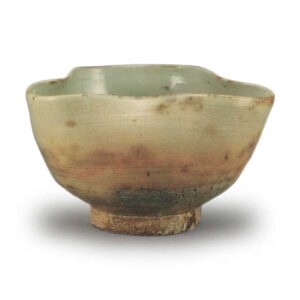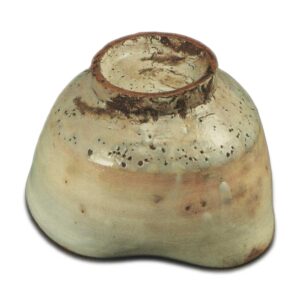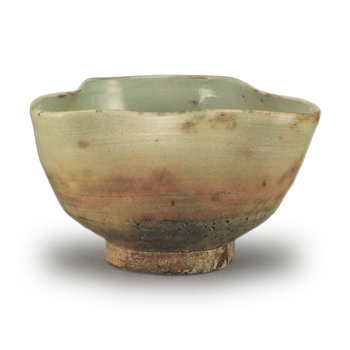

Height: 8.6 – 9.0 cm
Diameter: 11.5 – 14.7 cm
Outer diameter of foot ring: 6.9 cm
Height of foot ring: 1.7 cm
The body is a fresh shade of blue-white, with a faint blush and light purple running from the body to the waist.
The name Fujinami was probably given because of the strange coloring. The three large indentations around the rim are called “suhama-gata” and may be related to this.
The body is a whitish porcelain quality with a small amount of iron content, and the unglazed part with the foot ring is a bright brick red. It was fired in a neutral flame, which is a state between reducing and oxidizing flames, so the so-called “hon” (glaze) came out strongly, and the body below the neck became a light pink color. In addition, the glaze is slightly bluish, and in some places it is transparent in thin layers, while in other places it is milky and translucent. Furthermore, there are also places where the glaze has become light gray from the stains of tea stains that have entered through the holes in the glaze, and the color tone of the body glaze is quite subtle both inside and out. In particular, the glaze is thick on the inside and outside of the foot ring, and there are many large and small pits. In addition, the fingerprints and finger marks from when the glaze was applied are also visible, creating a complex and varied landscape in this area.
The shape is somewhat thin overall due to the simple potter’s wheel operation, but it is relaxed and spacious. The foot is large and elegant, standing firmly, and the rim is concave inwards on three sides, as if it were being held in. This is the only significant intentionality of this tea bowl, and this kind of distortion is also the most significant characteristic of the general Geumhae tea bowls.
It is said that the Ginkai tea bowls were made in Ginkai, near Busan, at the request of Japanese tea masters. Therefore, it goes without saying that they are made in a style that emphasizes the preferences of tea masters, which is common to Busan kilns. However, this Fujinami bowl seems to be somewhat different from the general Ginkai style. The overall shape is natural and generous, and the distortion around the rim is a random dent, so there is almost no sense of disharmony. This distortion around the rim was actually not made specifically for drinking tea, but for some other purpose, such as for pouring liquids, like a ladle. In other words, it is a simple, everyday vessel that just happens to resemble the usual Kinkai in both form and characteristics, and so it was probably mistaken for one. Looking at it in this way, it is natural to think that it was made before the Genwa period at the latest. The accessories are
Inner box: paulownia wood with plain lid. Written on the front of the lid: “Kan’ai-te teacup, shuhamagata.
Written on the back of the lid in gold: ”Owned by Fujinami Sōtan (signature).
It is said to have been owned by Sōtan and passed down through the Senke family, but the details are unknown. In the Taishō Meiki Kan, it is said to have been owned by Mr. Tokujirō Fujita of Osaka, and it is now in the possession of a certain family in the Kansai region.



